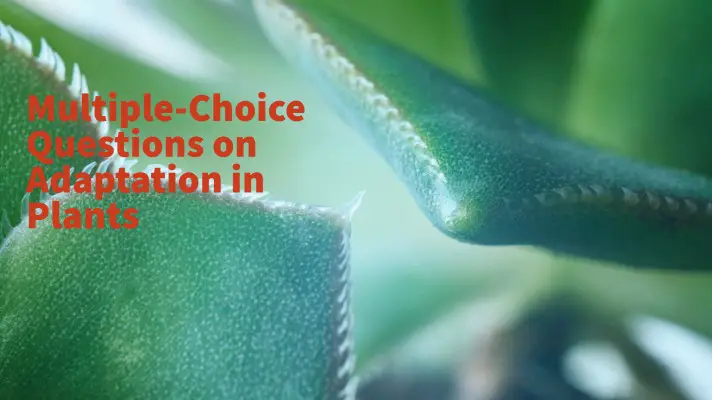Hello Readers! I hope that all of you are doing fine. I am here with a lot of Multiple-Choice Questions on Adaptation in Plants. While going through the Objective-type questions on Adaptation in Plants, you will come across some Amazing Facts about Plants and these are quite interesting. Let’s enjoy gaining more knowledge!
Further for getting the PDF version of this MCQ sheet in hand, click on the PDF downloadable button that you will get at the end of this article.

Multiple-Choice Questions on Adaptation in Plants For Class 4
Here are some MCQ questions on Adaptation in Plants:
- Terrestrial plants grow on:
- Land
- Water
- Both
Ans: (1)
- Aquatic plants grow on
- Land
- Water
- Both
Ans: (2)
- Terrestrial means:
- Land
- Water
- Living on land
- Living in water
Ans: (3)
- Which are the coldest places on our planet?
- Deserts
- Plain areas
- North and south poles
- None of these
Ans: (3)
- Which are the features of Polar regions?
- Very long winter and very short summer
- The air is cold and dry
- The plants grow close to the ground
- All of the above
Ans: (4)
- In this region, plants have a very thin layer of soil to grow.
- Mountains and hills
- Polar regions
- Plain areas
- All of the above
Ans: (2)
- In hilly regions, the higher you climb:
- The colder it gets
- The hotter it gets
- The more humid weather you get
- No matter, the temperature remains same
Ans: (1)
- Treeline is in:
- Polar regions
- Hilly regions
- Plain areas
- None of the above
Ans: (2)
- Which of the following plants can survive severe cold and snowfall?
- Berries
- Arctic poppy and purple saxifrage
- Pines and firs
- All of the above
Ans: (3)
- Which of the following plants are called evergreen trees?
- Arctic poppy and purple saxifrage
- Pines and firs
- Berries
- All of the above
Ans: (2)
- Which non-flowering plants grow in hilly areas?
- Arctic poppy and purple saxifrage
- Berries
- Ferns and mosses
- None of these
Ans: (3)
- The features of hilly areas’ plants are:
- They have a sloping conical structure
- They can survive severe cold and snowfall
- They have long and narrow needle-like leaves
- All of the above
Ans: (4)
- Which of the following regions have a distinct monsoon season?
- Polar regions
- Hilly areas
- Plain areas
- Deserts
Ans: (3)
- Banyan and Peepal trees grow in:
- Polar regions
- Hilly areas
- Plain areas
- Deserts
Ans: (3)
- Which trees begin to shed their leaves in Autumn?
- Trees of Plain areas
- Trees of Desert areas
- Trees of Hilly areas
- Trees of Polar regions
Ans: (1)
- Deciduous trees grow in:
- Desert areas
- Hilly areas
- Polar regions
- Plain areas
Ans: (4)
- The features of deciduous trees are:
- Begin to shed their leaves in Autumn
- New leaves grow in Spring
- Both (1) and (2)
- None of the above
Ans: (3)
- The features of the plants that grow in desert areas:
- The sand keeps shifting
- Plants survive the scarcity of water and also long periods of drought
- The stem of the plants stores up water during rains
- All of the above
Ans: (4)
- The most famous plant in the desert is:
- Cactus
- Berries
- Ferns
- Mosses
Ans: (1)
- In which of the areas, the stem has a waxy surface?
- Polar regions
- Hilly areas
- Plain areas
- Deserts
Ans: (4)
- Which portion of the plants’ stores water in the desert areas?
- Root
- Leaves
- Stem
- Seeds
Ans: (3)
- The leaves are reduced to spines in:
- Polar regions
- Hilly areas
- Plain areas
- Deserts
Ans: (4)
- Which cactus is used for medicinal benefits?
- Arctic poppy
- Purple saxifrage
- Alovera
- Ball cactus
Ans: (3)
- The air is salty in:
- Polar regions
- Coastal areas
- Plain areas
- Deserts
Ans: (2)
- Which plants need a warm humid climate?
- Peepal and Banyan tree
- Palm and coconut plants
- Alovera and ball cactus
- None of these
Ans: (2)
- The warm humid climates are available in:
- Desert areas
- Plain areas
- Hilly areas
- Coastal areas
Ans: (4)
- The features of the plants that grow in coastal areas are:
- They have strong and flexible stems
- They do not shed their all leaves at a time
- The fruits and seeds of these plants get scattered
- All of these
Ans: (4)
- Breathing roots are available in
- Mangrove areas
- Polar regions
- Desert regions
- Hilly areas
Ans: (1)
- Which of the following is floating?
- Water lilies
- Pistia
- Hydrilla
- Pitcher plant
Ans: (2)
- Which of the following are fixed plants in water?
- Water lilies
- Pistia
- Hydrilla
- Pitcher plant
Ans: (1)
- Which of the following are submerged plants?
- Water lilies
- Pistia
- Hydrilla
- Pitcher plant
Ans: (3)
- Which of the following are insectivorous plants?
- Water lilies
- Pistia
- Hydrilla
- Pitcher plant
Ans: (4)
- Find the odd one:
- Hydrilla
- Tapergrass
- Sundew
- Pondweed
Ans: (3)
- Find the odd one:
- Venus flytrap
- Pitcher plant
- Sundew
- Pondweed
Ans: (4)
- Find the odd one:
- Pistia
- Lotus
- Duckweed
- Water lettuce
Ans: (2)
Quiz on Adaptation in Plants
Worksheet on Adaptation in Plant
Fill in the blanks: (1×10=10)
- The natural home of a plant is known as __.
- Tape grass is a __ plant.
- Plants that grow on land are known as __.
- About __ % of Earth’s water is freshwater.
- Aquatic plants are of __ types.
- Plants that grow on land are known as __.
- __ and __ are the coldest places on our Earth.
- __ and __ can survive severe cold and rainfall.
- __ are the hottest and driest places in the world.
- The __ Desert in __ has some of the tallest shifting sand dunes.
Answer the following questions.(10×2=20)
- What do you mean by “Adaptation”?
- Name some plants that exhibit huddling behavior?
- Why do the plants that grow in the polar region hibernate?
- Why do the trees that grow in valleys shed their leaves in the Autumn?
- How can you differ Pine trees from Coconut trees?
- Indicate some special characteristics of Mangrove trees?
- Name some insectivorous plants?
- What are Saprophytic plants? Give some examples.
- Which plants are known as evergreen trees? Give some examples.
- Which plants are known as deciduous trees? Indicate some examples.
State True or False (1×8=8)
- Sundew is a submerged plant.
- The Cactus is the most famous desert plant.
- Pistia is a submerged plant.
- Treeline is the line on trees, beyond which no leaves are seen.
- Palm trees are found in Coastal regions.
- The Aloe vera gel has many medicinal benefits.
- No cacti produce flowers.
Conclusion
I hope that you all have enjoyed the article on Multiple-Choice Questions on Adaptation in Plants. This will surely help you in achieving a high score in your school examination / competitive examination. Wish you all the best!


